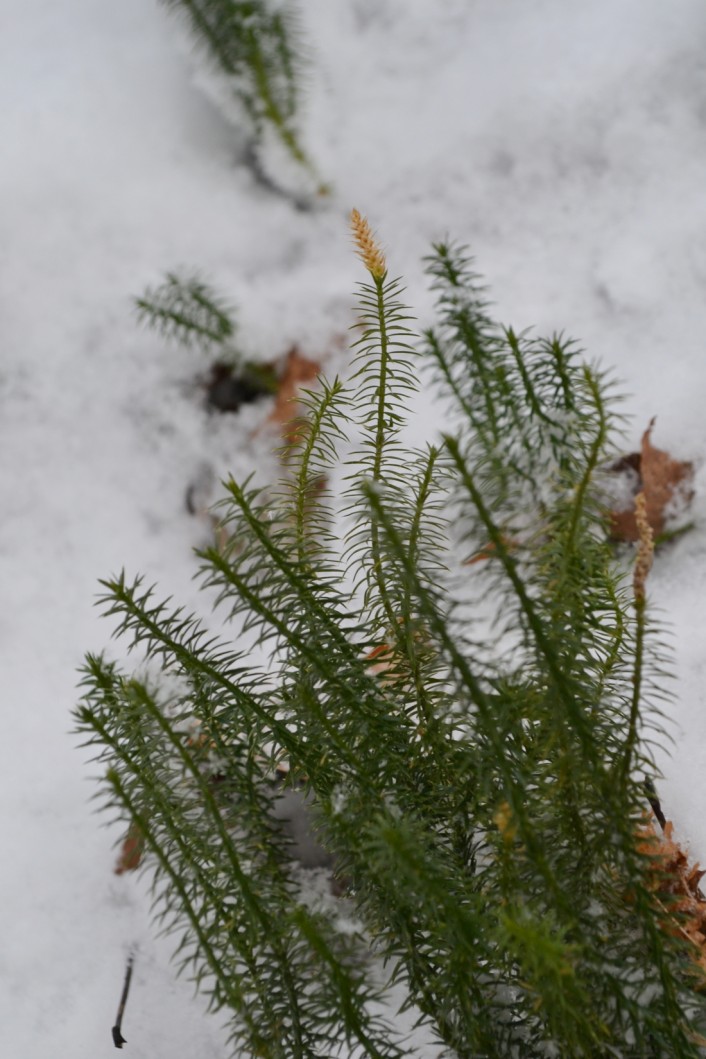Now that late fall is here and leaves have fallen from the trees, it may seem like there isn’t much to see in our area forests until springtime.
There is however a variety of woodland evergreen plants to discover right now, displaying their dark green foliage against the brown leaf litter and light snow. Although they all retain their green colour through the winter, they represent a wide range in the plant kingdom. They are all hardy, surviving frigid temperatures, and cold dry winds. Adapting to such harsh conditions is truly remarkable.
All plants need water to survive, and obtaining this essential commodity is nearly impossible in the winter because the ground is frozen. Most evergreen plants have been able to manage this obstacle by developing woody stems and leaves or needles with waxy-coatings. This cuts down on evaporation, preserving the water they collected during warmer weather. Many plants have developed another adaptation against evaporation, growing low to the ground where they are less likely to suffer from severe winter winds. The evergreen leaves may also help the plant by allowing for a longer period of photosynthesis since they can obtain energy early in the spring and late into the fall.
Our short growing season limits the amount of energy plants can put towards reproduction. Rather than waste this energy on flowers, many of the evergreen plants depend on vegetative reproduction, either by underground roots or trailing stems.
Here is a selection of interesting and commonly found evergreen plants in our area.
Christmas fern: As its name suggests, this attractive medium-sized fern has evergreen fronds that are often used for festive floral arrangements and seasonal decorations. Christmas ferns can be found growing in rich soils in mature woods.
Clubmosses (Lycopodeum species): This group of ancient plants includes a species that is often mistaken for miniature evergreen trees; however they are no relation. Clubmosses reproduce by means of rootstocks and form dense colonies. The plants are able to start new colonies as well by producing spores that can be spread by the wind.
Pipsissewa: Commonly found in dry oak and pine forests, pipsissewas grow in groups or as individual plants connected by an underground rootstock. The leaves are shiny and grow in whorls around a tall stalk that produces small flowers in the summer. Sometimes the dried stalk and flower pod are all that can be seen above the snow.
Leatherleaf: Look for this evergreen shrub along the edges of acidic bogs where it grows to heights of two to four feet (60–120 cm). The leaves are flat, wide, and shiny and often turn a dark red-brown in the winter. As their name suggests, the leaves are also very thick and leathery. After producing white, bell-shaped flowers in the spring, the winter seed pods provide food for birds such as ruffed grouse.
Cranberry: Another denizen of acidic bogs, cranberries are trailing plants that grow low to the ground. Their shallow rootstocks send roots down and stems upwards. The plants produce evergreen leaves that are small and round. The small white flowers appear in the spring and the famous, tart berries appear in the fall; they are white at first and then turn red as they ripen.
Many of the properties protected by the Couchiching Conservancy provide ideal conditions for these unusual and important plants to thrive. The Thomas C. Agnew property in Washago is just one of the properties where many of these plants can be found.
Gayle Carlyle is a volunteer with The Couchiching Conservancy, a local land trust that currently helps protect more than 11,000 acres of natural land. Visit the website: www.couchichingconserv.ca for more information. Follow us on Facebook and Twitter.

